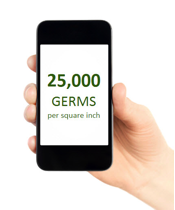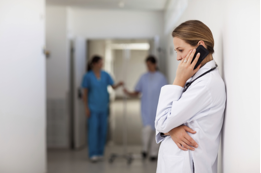Original post by Patrick Boshell of ‘The Deb Group’, on Wednesday July 17, 2013
“It’s a well-known fact that cell phones are dirty objects, but just how unclean are they? Fun fact: each square inch of your cell phone contains roughly 25,000 germs, making it one of the filthiest things you come in contact with on a daily basis. That’s something to think about the next time you press your face to your phone.
Ever wonder what objects are actually cleaner than your phone? Surprisingly, toilet seats make the list because they’re usually sanitized often. Watch the video http://www.youtube.com/watch?v=x00otjSL6GQ&feature=player_embedded to see how an average cell phone’s bacterial count stacks up compared to other household items,” as reported by Mashables.
Menshealth recently interviewed Dr. Charles Gerba, a professor of microbiology at the University of Arizona who says this is not surprising. “Nobody ever cleans or disinfects their phone, so the germs and bacteria just keep building up,” he explains. What types of germs? E. coli, as well as influenza and MRSA, a germ that causes rashes and skin infections, Gerba adds.
 As we use our phones frequently it remains warm, creating the ideal breeding ground for bacteria. “With the advent of touch-screen phones, the same part of the phone you touch with your fingertips is pressed right up against your face and mouth, upping your chances of infection,” Gerba adds.
As we use our phones frequently it remains warm, creating the ideal breeding ground for bacteria. “With the advent of touch-screen phones, the same part of the phone you touch with your fingertips is pressed right up against your face and mouth, upping your chances of infection,” Gerba adds.
A recent article explored some of those terrifying germs and summarized details from a study involving 200 phones as published in the “Annals of Clinical Microbiology and Antimicrobials.”
“The researchers found that 94.5 percent of the phones were contaminated with some kind of bacteria, many of which were resistant to multiple antibiotics. By also testing the participants’ hands, the researchers were able to show that a significant number of germs were transferred from their hands to their phones, and vice versa. In fact, about 30 percent of the bacteria on the phones ended up on the owner’s hands.
Much of the disease-causing bacteria they found are transferred from person to person through touch, which means that once this bacteria is on your hands, you only have to then touch your eyes or nose for the bacteria to find an easy route into your body. This is especially frightening when you consider how often your phone hangs out only millimeters away from your face.
The wide spread use of mobile phones by healthcare workers has become a question of concern. A recent study study on mobile phones and Nosocomial infections reported, “HCWs’ mobile phones may serve as reservoirs for microorganisms that could facilitate the transmission of bacterial isolates from one patient to another in different hospital wards. Whereas strict attention is paid to changing clothes, removing jewelry, undertaking hand hygiene measures (WHO 5 Moments), and storing personal objects in changing rooms to reduce the transfer of microorganisms from the external clinical environment into the operating environment, most expensive mobile phones often accompany staff into the operating environment as currently no local policy restricting the use of mobile phones in clinically sensitive areas is in place. This lack of attention may be indicative of little awareness about potential risks posed by mobile phone microbial contamination and their role as vehicle for transmission of infections.”
 The report went on to recommend, “Restriction of mobile phone use in clinically sensitive areas, such as operating environment and ICU as a start point, is recommended. Moreover, screening of HCWs’ mobile phones inside the hospital should be done while doing environmental screening.” This would be supported by, “A major educational campaign to raise awareness” and recommendation that “mobile phones could be produced with protective material against contamination.”
The report went on to recommend, “Restriction of mobile phone use in clinically sensitive areas, such as operating environment and ICU as a start point, is recommended. Moreover, screening of HCWs’ mobile phones inside the hospital should be done while doing environmental screening.” This would be supported by, “A major educational campaign to raise awareness” and recommendation that “mobile phones could be produced with protective material against contamination.”
A new Practice Guideline was issued by the Community and Hospital Infection Control Association (CHICA-Canada) to address the issues of electronic devices in healthcare settings. Recommendations coming out of that guideline include the following:
Hand hygiene should be performed between patient contact and before and after accessing a device.
- Manufacturer’s guidelines for use, cleaning/disinfection and maintenance should be reviewed to ensure these guidelines meet the standards for cleaning and low-level disinfection that are necessary for exposure to Multi-Drug-Resistant Organisms.
- Items that cannot be adequately cleaned should not be used, or should be designated as “clean” and not be accessed in patient rooms or be touched by patients.
- If an item cannot be cleaned with a hospital-grade disinfectant and is necessary for patient care, a risk assessment should be done with infection prevention and control to determine the best approach to mitigate the risk of transmission of microorganisms.
- All touch-surfaces of IT devices used at, or near, point-of-care must be cleaned and disinfected with a hospital-grade disinfectant if used or touched during the encounter with the patient.
- The surface of telephone components, pagers and computer ‘mice’ should be cleaned in a manner that prevents damage to internal systems from excessive fluid.
- If an item cannot be adequately cleaned and will be accessed in a patient room or touched by patients, it requires a cleanable cover.
- The user/owner of the device is responsible for routine cleaning and disinfection of the device and that responsibility must be clearly communicated.
© 2013 Deb Group Ltd.
Reprinted by permission; originally posted at http://info.debgroup.com/blog/bid/290652/your-mobile-phone-is-dirtier-than-you-think?source=Blog_Email_[Your%20Mobile%20Phone%20Is]
2Ascribe Inc. is a medical transcription services agency located in Toronto, Ontario Canada, providing medical transcription services to physicians, clinics and other healthcare providers across Canada. Having recently introduced WEBscribe, a client interface portal for document management, 2Ascribe continues to implement and develop technology to assist and improve the transcription process for physicians and other healthcare providers. As a service to our clients and the healthcare industry, 2Ascribe offers articles of interest to physicians and other healthcare professionals, medical transcriptionists and office staff, as well as of general interest. Additional articles may be found at http://www.2ascribe.com/category/articles/dictation-tips and http://www.2ascribe.com/category/articles.
To receive notification of new articles and to subscribe to 2Ascribe’s newsletter, go to www.2Ascribe.com, scroll to the bottom of the home page and enter your name and email address.

